The automotive transmission synchronizer assembly market is anticipated to grow from USD 1,693.6 million in 2025 and is expected to reach USD 2,412.2 million by 2035, registering a CAGR of 3.6%. The market shows a steady growth pattern, with revenue rising from USD 1,419.1 million in 2020 to USD 1,693.6 million in 2025. This initial phase highlights moderate adoption driven by rising production of manual and semi-automatic vehicles in cost-sensitive markets. Incremental growth during this period reflects the replacement cycle in existing vehicle fleets and the continued role of synchronizer assemblies in supporting efficiency and drivability.
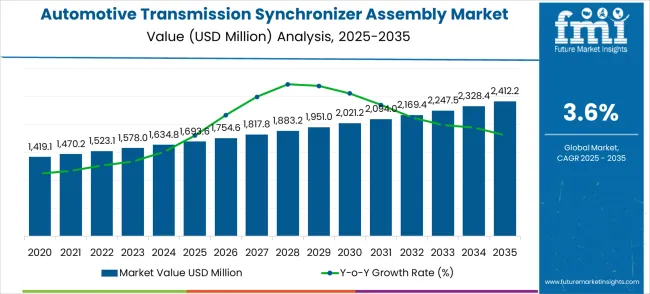
| Metric | Value |
|---|---|
| Market Value (2025) | USD 1,693.6 million |
| Market Forecast Value (2035) | USD 2,412.2 million |
| Forecast CAGR (2025-2035) | 3.6% |
Between 2025 and 2030, the market expands from USD 1,693.6 million to USD 2,021.2 million, marking the first key breakpoint in its growth trajectory. This stage reflects consistent adoption as demand for affordable vehicles persists in developing regions where manual and semi-automatic transmissions remain prevalent. Automakers focus on optimizing transmission performance and durability, contributing to steady revenue gains. Incremental year-on-year increases signal a stable yet slow expansion phase, highlighting the synchronizer assembly’s enduring role despite the growing shift toward electrified drivetrains in advanced markets.
From 2030 to 2035, revenue grows from USD 2,021.2 million to USD 2,412.2 million, representing the second breakpoint and final growth phase. Expansion in this stage is fueled by sustained demand from replacement markets, fleet upgrades, and continued reliance on traditional transmission systems in commercial vehicles and low-cost passenger cars. While global adoption of electric vehicles reduces the long-term reliance on synchronizer assemblies, steady demand in select markets ensures ongoing growth. By 2035, the market demonstrates a mature, stable trajectory with slower but consistent increases, reflecting the balance between traditional vehicle demand and gradual transition to alternative drivetrain technologies.
Market expansion is being supported by steady advances in transmission technology development and automotive manufacturing consistency, creating ongoing opportunities for enhanced gear shifting and comprehensive transmission performance optimization. Modern automotive applications consistently demand sophisticated synchronizer assemblies that enable smooth gear engagement, support transmission durability, and provide reliable shifting capabilities for manual transmission and automated transmission systems. The integration of advanced materials technology with comprehensive transmission engineering enables consistent levels of shifting precision and automotive transmission reliability.
The growing focus on automotive transmission efficiency and driving comfort is driving steady demand for automotive transmission synchronizer assemblies from established automotive manufacturers with proven track records of innovation and transmission expertise. Automotive companies and transmission suppliers are investing consistently in synchronizer assembly technologies that offer superior shifting quality while providing enhanced transmission durability and comprehensive automotive integration through advanced transmission engineering protocols. Automotive standards are establishing performance benchmarks that favor precision synchronizer assemblies with advanced materials capabilities and superior transmission integration features.
The automotive industry's steady evolution toward enhanced transmission performance is creating consistent demand for intelligent synchronizer assembly products capable of delivering reliable gear shifting and automotive integration through advanced transmission component platforms. The transmission sector continues to drive steady innovation in automotive component applications while maintaining quality reliability and operational efficiency, leading to development of consistent synchronizer assemblies with enhanced durability capabilities and comprehensive transmission integration.
The market is segmented by synchronizer type, application, and region. By synchronizer type, the market is divided into single-cone synchronizer, double-cone synchronizer, and triple-cone synchronizer configurations. Based on application, the market is categorized into manual transmission (MT), automated manual transmission (AMT), and dual clutch transmission (DCT) applications. Regionally, the market is divided into North America, Europe, East Asia, South Asia & Pacific, Latin America, and Middle East & Africa.
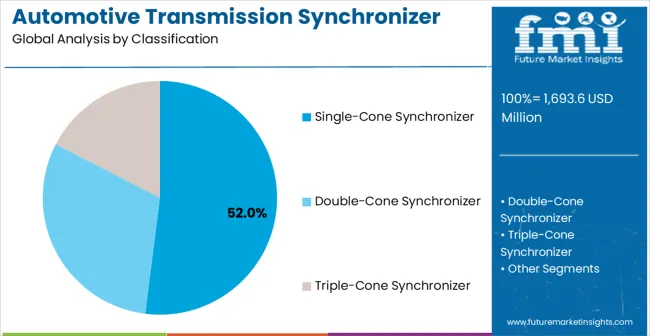
Single-cone synchronizer configurations are projected to account for 52% of the automotive transmission synchronizer assembly market in 2025. This leading share is supported by consistent adoption of cost-effective synchronization requirements and steady demand for reliable gear shifting through proven synchronizer technology. Single-cone synchronizers provide dependable shifting performance and transmission integration capabilities, making them the preferred choice for automotive manufacturers seeking comprehensive transmission solutions and enhanced production cost efficiency. The segment benefits from mature advances in synchronizer materials technology, transmission integration systems, and manufacturing optimization solutions that have created established categories of reliable transmission synchronizer components.
Modern single-cone synchronizers incorporate proven materials engineering and established transmission integration systems that enable consistent gear engagement, reliable shifting performance, and seamless integration with transmission assemblies while ensuring superior durability and comprehensive automotive integration. These proven technologies have established automotive transmission reliability while providing dependable shifting capabilities for transmission performance and automotive integration through continuous component optimization and established transmission engineering.
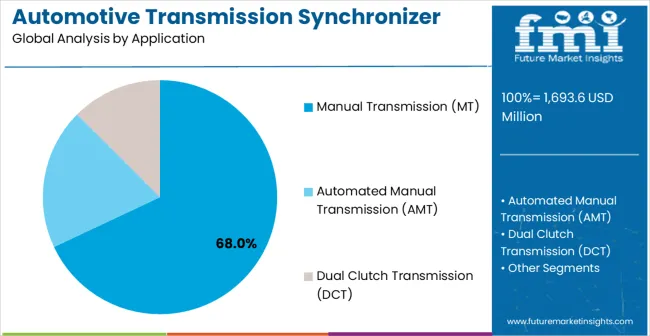
Manual transmission (MT) applications are expected to represent 68% of automotive transmission synchronizer assembly demand in 2025. This dominant share reflects the substantial automotive market for manual transmission systems and steady investment in transmission component technologies for comprehensive automotive applications. Manual transmission applications enable comprehensive gear shifting through proven synchronizer assemblies, established transmission systems, and reliable automotive integration platforms. The segment benefits from steady advances in manual transmission technology that makes sophisticated synchronizer assembly integration accessible and essential for transmission reliability and automotive performance optimization.
The global automotive industry drives consistent demand for manual transmission synchronizer assemblies that provide dependable shifting capabilities and reliable transmission integration for automotive performance and transmission efficiency applications. These applications require synchronizer assemblies with superior reliability abilities and comprehensive manual transmission integration to ensure dependable gear shifting and effective transmission performance capabilities. The segment benefits from steady automotive investment in transmission component technologies and consistent implementation of established transmission systems and comprehensive automotive solutions.
The automotive transmission synchronizer assembly market is advancing steadily due to consistent transmission technology development and steady adoption of automotive component technologies across all manual transmission and automotive manufacturing segments. However, the market faces challenges including component cost considerations, need for reliable performance validation, and varying transmission requirements across different automotive applications. Automotive quality standards and transmission regulations continue to influence product development and market adoption patterns.
The steady advances in synchronizer materials, transmission integration algorithms, and established automotive technologies are enabling consistent automotive transmission capabilities while maintaining component reliability and operational efficiency standards. Advanced materials architectures and transmission-specific synchronizer systems provide superior shifting quality and transmission integration capabilities, enabling steady automotive optimization and enhanced transmission reliability. These technologies are particularly valuable for automotive applications that require sophisticated transmission integration, reliable gear shifting, and dependable automotive standardization protocols.
Modern automotive transmission synchronizer assembly manufacturers are implementing steady ecosystem integration and comprehensive transmission platform development that enables seamless automotive integration while supporting consistent transmission optimization and performance management enhancement. Advanced platform architectures enable unified transmission control, automotive monitoring, and performance management while ensuring transmission reliability and automotive operational requirements.
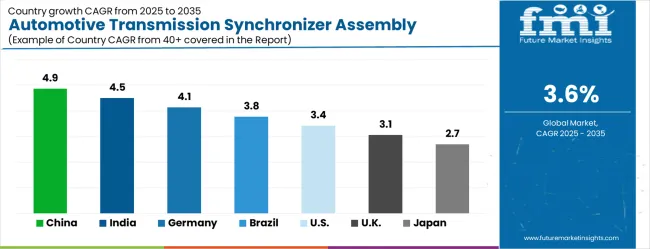
| Country | CAGR (2025-2035) |
|---|---|
| China | 4.9% |
| India | 4.5% |
| Germany | 4.1% |
| Brazil | 3.8% |
| United States | 3.4% |
| United Kingdom | 3.1% |
| Japan | 2.7% |
The automotive transmission synchronizer assembly market is experiencing steady growth, with China leading at 4.9% CAGR through 2035, driven by consistent automotive manufacturing expansion and steadily growing automotive component infrastructure. India follows at 4.5%, supported by substantial automotive development potential and increasing transmission component investment. Germany records solid growth at 4.1%, emphasizing automotive technology innovation excellence and advanced transmission component development. Brazil grows steadily at 3.8%, benefiting from expanding automotive manufacturing and transmission component development. The United States shows consistent growth at 3.4%, focusing on automotive technology advancement and precision transmission applications. The United Kingdom maintains steady expansion at 3.1%, supported by automotive innovation development. Japan demonstrates stable growth at 2.7%, emphasizing precision transmission technology and automotive excellence.
The report covers an in-depth analysis of 40+ countries top-performing countries are highlighted below.
China is expected to record the highest expansion in automotive transmission synchronizer assemblies at a CAGR of 4.9% through 2035, driven by the country's position as a global automotive manufacturing leader and substantial domestic investment in transmission component infrastructure. The extensive automotive assembly capabilities and consistent investment in transmission technology development are creating significant opportunities for synchronizer assembly adoption. Major automotive and transmission companies are developing established transmission component capabilities to serve both the substantial domestic automotive market and global transmission expansion while maintaining leadership in automotive component applications.
India is witnessing expansion in automotive transmission synchronizer assemblies at a CAGR of 4.5%, supported by the country's substantial automotive development potential and steadily accelerating transmission manufacturing across all automotive segments and production operations. The substantial automotive manufacturing growth and increasing transmission component investment are driving significant synchronizer assembly demand potential. Automotive technology companies are leveraging India's substantial automotive market while developing cost-effective transmission component solutions to capture emerging opportunities in automotive assembly and transmission manufacturing applications.
The automotive transmission synchronizer assembly sector in Germany is anticipated to post a CAGR of 4.1%, supported by the country's leadership in automotive technology innovation and advanced transmission component development across automotive, engineering, and manufacturing sectors. German transmission component companies are implementing sophisticated synchronizer assembly development that meets stringent quality standards and automotive requirements while delivering superior transmission properties and component reliability. The market is characterized by focus on automotive innovation, advanced technology integration, and compliance with comprehensive transmission quality and automotive efficiency regulations.
Brazil is forecasted to record steady growth in automotive transmission synchronizer assemblies at a CAGR of 3.8%, driven by expanding automotive manufacturing and increasing transmission component investment across urban and emerging automotive market segments. The growing automotive awareness and increasing transmission infrastructure development are creating substantial opportunities for synchronizer assembly market development. Automotive technology companies are adapting transmission components to support growing automotive demand and transmission manufacturing while maintaining cost accessibility and local market relevance.
Automotive transmission synchronizer assemblies in the United States are projected to advance at a CAGR of 3.4%, driven by the country's automotive technology advancement and automotive market demand for advanced transmission components and established automotive technologies. The sophisticated automotive infrastructure and automotive willingness to invest in advanced synchronizer assemblies create consistent demand for high-performance automotive solutions. The market benefits from established transmission component research and automotive-grade technology market segments across automotive, commercial, and industrial applications.
Automotive transmission synchronizer assemblies in the United Kingdom are forecasted to advance at a CAGR of 3.1%, supported by ongoing automotive innovation advancement and increasing automotive demand for dependable transmission components in automotive and commercial applications. Transmission component companies are investing in automotive technology development that provides advanced functionality while meeting quality requirements and regulatory compliance for automotive applications. The market is characterized by focus on automotive innovation, transmission quality protection, and advanced technology integration across diverse automotive segments.
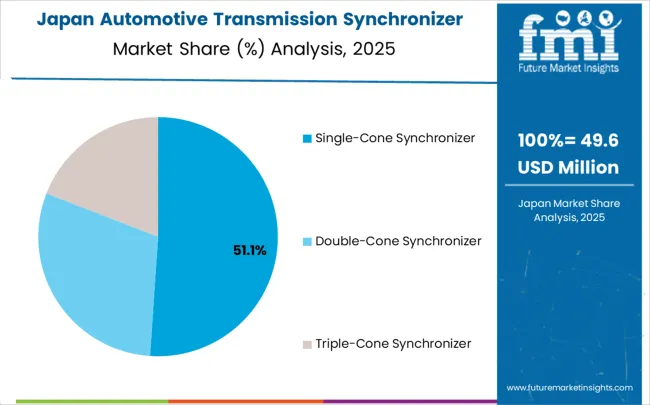
Automotive transmission synchronizer assemblies in Japan are expected to advance at a CAGR of 2.7%, driven by the country's emphasis on transmission component excellence and precision automotive development across automotive, electronics, and manufacturing sectors. Japanese transmission component companies are developing sophisticated synchronizer assembly applications that incorporate precision engineering and automotive optimization principles. The market benefits from focus on transmission precision, component reliability, and continuous innovation in automotive technology and transmission assembly integration.
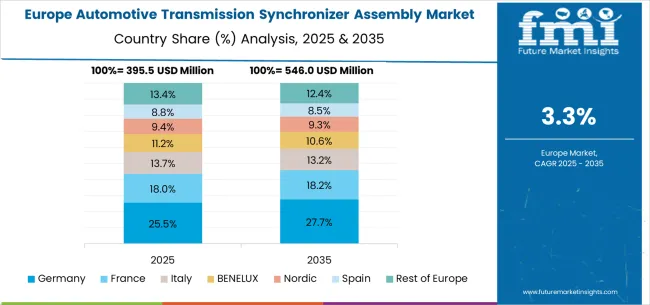
The automotive transmission synchronizer assembly market in Europe is projected to grow from USD 453.5 million in 2025 to USD 646.1 million by 2035, registering a CAGR of 3.6% over the forecast period. Germany is expected to maintain its leadership with a 38.7% share in 2025, supported by its advanced automotive manufacturing industry and transmission component excellence. The United Kingdom follows with 19.8% market share, driven by automotive innovation advancement and transmission component development. France holds 16.4% of the European market, benefiting from automotive technology expansion and transmission component industry development. Italy and Spain collectively represent 15.2% of regional demand, with growing focus on automotive development and transmission component applications. The Rest of Europe region accounts for 9.9% of the market, supported by transmission component development in Eastern European countries and Nordic automotive innovation advancement.
The automotive transmission synchronizer assembly market underpins automotive transmission evolution, component technology advancement, transmission reliability democratization, and automotive performance optimization evolution. With steady automotive production, transmission component expansion, and quality requirements, the sector faces pressure to balance innovation velocity, component quality protection, and transmission performance validation. Coordinated contributions from governments, industry bodies, OEMs/technology integrators, suppliers, and investors will accelerate the transition toward beneficial, reliable, and universally accessible automotive transmission synchronizer assembly ecosystems.
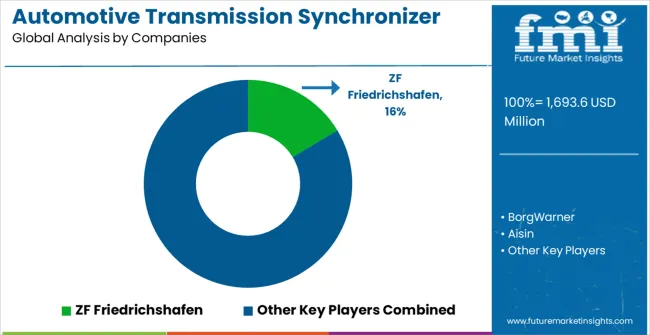
The automotive transmission synchronizer assembly market is defined by steady competition among transmission component manufacturers, established automotive technology companies, and reliable automotive component suppliers. Companies are investing in transmission component development, advanced assembly design, transmission quality validation, and automotive ecosystem integration to deliver reliable, efficient, and automotive-compatible synchronizer assemblies. Strategic partnerships, technological advancement, and consistent automotive market expansion are central to achieving market leadership and automotive adoption.
ZF Friedrichshafen, operating globally, offers comprehensive transmission component solutions with focus on automotive and commercial applications, transmission performance optimization, and seamless automotive integration across synchronizer assemblies, transmission systems, and automotive services applications. BorgWarner, technology provider, delivers advanced transmission components with emphasis on automotive reliability, transmission performance, and intelligent automotive integration capabilities. Aisin provides innovative transmission solutions with focus on comprehensive automotive integration and high-performance transmission applications. Schaeffler Group offers precision transmission components with advanced synchronizer assembly technology and automotive-grade performance capabilities.
Eaton provides specialized transmission components with emphasis on automotive and commercial applications. Zhejiang Xunda Industry delivers established transmission component technology with sophisticated automotive performance and transmission optimization capabilities. Haoneng Technology offers comprehensive transmission solutions with automotive integration and transmission component services. Hoerbiger provides transmission components with advanced automotive integration and transmission systems.
Wuhan Kyowa Synchronizer Ring co., LTD, Guangyang Bearing, and Oerlikon offer specialized transmission component expertise, innovative product development, and technical advancement across synchronizer assembly and automotive transmission technology networks.
| Item | Value |
|---|---|
| Quantitative Units | USD 1,693.6 million |
| Synchronizer Type | Single-Cone Synchronizer, Double-Cone Synchronizer, Triple-Cone Synchronizer |
| Application | Manual Transmission (MT), Automated Manual Transmission (AMT), Dual Clutch Transmission (DCT) |
| Regions Covered | North America, Europe, East Asia, South Asia & Pacific, Latin America, Middle East & Africa |
| Country Covered | United States, Germany, India, China, United Kingdom, Japan, Brazil, and other 40+ countries |
| Key Companies Profiled | ZF Friedrichshafen, BorgWarner, Aisin, Schaeffler Group, Eaton, Zhejiang Xunda Industry, Haoneng Technology, Hoerbiger, Wuhan Kyowa Synchronizer Ring co., LTD, Guangyang Bearing, Oerlikon |
The global automotive transmission synchronizer assembly market is estimated to be valued at USD 1,693.6 million in 2025.
The market size for the automotive transmission synchronizer assembly market is projected to reach USD 2,412.2 million by 2035.
The automotive transmission synchronizer assembly market is expected to grow at a 3.6% CAGR between 2025 and 2035.
The key product types in automotive transmission synchronizer assembly market are single-cone synchronizer, double-cone synchronizer and triple-cone synchronizer.
In terms of application, manual transmission (mt) segment to command 68.0% share in the automotive transmission synchronizer assembly market in 2025.






Our Research Products

The "Full Research Suite" delivers actionable market intel, deep dives on markets or technologies, so clients act faster, cut risk, and unlock growth.

The Leaderboard benchmarks and ranks top vendors, classifying them as Established Leaders, Leading Challengers, or Disruptors & Challengers.

Locates where complements amplify value and substitutes erode it, forecasting net impact by horizon

We deliver granular, decision-grade intel: market sizing, 5-year forecasts, pricing, adoption, usage, revenue, and operational KPIs—plus competitor tracking, regulation, and value chains—across 60 countries broadly.

Spot the shifts before they hit your P&L. We track inflection points, adoption curves, pricing moves, and ecosystem plays to show where demand is heading, why it is changing, and what to do next across high-growth markets and disruptive tech

Real-time reads of user behavior. We track shifting priorities, perceptions of today’s and next-gen services, and provider experience, then pace how fast tech moves from trial to adoption, blending buyer, consumer, and channel inputs with social signals (#WhySwitch, #UX).

Partner with our analyst team to build a custom report designed around your business priorities. From analysing market trends to assessing competitors or crafting bespoke datasets, we tailor insights to your needs.
Supplier Intelligence
Discovery & Profiling
Capacity & Footprint
Performance & Risk
Compliance & Governance
Commercial Readiness
Who Supplies Whom
Scorecards & Shortlists
Playbooks & Docs
Category Intelligence
Definition & Scope
Demand & Use Cases
Cost Drivers
Market Structure
Supply Chain Map
Trade & Policy
Operating Norms
Deliverables
Buyer Intelligence
Account Basics
Spend & Scope
Procurement Model
Vendor Requirements
Terms & Policies
Entry Strategy
Pain Points & Triggers
Outputs
Pricing Analysis
Benchmarks
Trends
Should-Cost
Indexation
Landed Cost
Commercial Terms
Deliverables
Brand Analysis
Positioning & Value Prop
Share & Presence
Customer Evidence
Go-to-Market
Digital & Reputation
Compliance & Trust
KPIs & Gaps
Outputs
Full Research Suite comprises of:
Market outlook & trends analysis
Interviews & case studies
Strategic recommendations
Vendor profiles & capabilities analysis
5-year forecasts
8 regions and 60+ country-level data splits
Market segment data splits
12 months of continuous data updates
DELIVERED AS:
PDF EXCEL ONLINE
Automotive Direct Liquid Cooling IGBT Module Market Size and Share Forecast Outlook 2025 to 2035
Automotive Hoses and Assemblies Market Size and Share Forecast Outlook 2025 to 2035
Automotive Network Testing Market Size and Share Forecast Outlook 2025 to 2035
Automotive Performance Part Market Size and Share Forecast Outlook 2025 to 2035
Automotive Carbon Ceramic Brake Market Size and Share Forecast Outlook 2025 to 2035
Automotive Camshaft Market Size and Share Forecast Outlook 2025 to 2035
Automotive Stamping Industry Analysis in India Size and Share Forecast Outlook 2025 to 2035
Automotive Cylinder Liner Market Size and Share Forecast Outlook 2025 to 2035
Automotive Microcontroller Market Size and Share Forecast Outlook 2025 to 2035
Automotive Roof Rails Market Size and Share Forecast Outlook 2025 to 2035
Automotive Active Safety System Market Size and Share Forecast Outlook 2025 to 2035
Automotive Diagnostic Scan Tool Market Size and Share Forecast Outlook 2025 to 2035
Automotive Test Equipment Market Size and Share Forecast Outlook 2025 to 2035
Automotive Dynamic Map Data Market Size and Share Forecast Outlook 2025 to 2035
Automotive Green Tires Market Size and Share Forecast Outlook 2025 to 2035
Automotive E-Tailing Market Size and Share Forecast Outlook 2025 to 2035
Automotive Interior Market Forecast Outlook 2025 to 2035
Automotive Key Market Size and Share Forecast Outlook 2025 to 2035
Automotive Appearance Chemical Market Forecast and Outlook 2025 to 2035
Automotive Seating Market Forecast and Outlook 2025 to 2035

Thank you!
You will receive an email from our Business Development Manager. Please be sure to check your SPAM/JUNK folder too.
Chat With
MaRIA